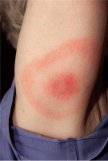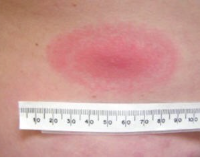Specialist Advice — 9 minutes
When black-legged ticks gain ground
April 23, 2025

Written in collaboration with Dre Marie Farmer M.D., Ph. D.
Lyme disease is an infection caused by the B. Burgdorferi bacterium, transmitted by a single variety of ticks: the black-legged tick. Some infected individuals do not feel any symptoms at all or have very mild symptoms. For others, the disease appears in three to 30 days, and sometimes even up to three months after the bite, specifically in the form of redness on the skin alone or accompanied by symptoms similar to those of the flu: fever, fatigue, headache, and joint and muscle pain. Left untreated, the infection can cause serious complications in the weeks or months that follow, such as heart rhythm disorders, severe joint pain, or even chronic meningitis.[1]
How to identify a black-legged tick?
Ticks are not insects and they do not fly. They are mites: tiny parasites, often difficult to see with the naked eye, that feed exclusively off blood.
In Quebec, there are dozens of tick species that may bite humans and animals. The black-legged tick (Ixodes scapularis) is one of them and is the main one responsible for the transmission of Lyme disease. In 2024, over 680 cases of this disease were reported in the province, 568 of which were confirmed to have been locally contracted.[2]
Black-legged ticks are found mainly in regions with a high white-tailed deer, also called roe deer, and white-footed mouse population. Initially concentrated in Montérégie, Estrie and southern Ontario, its presence is extending northward at an estimated rate of 33–55 km per year. With the effects of global warming, this expansion is expected to continue.[3] Already, in 2024, more than 20% of Lyme disease cases have been reported north of the St. Lawrence River, including one confirmed case in Abitibi-Témiscamingue.[2]
 Illustration from reference 4
Illustration from reference 4
It’s not always easy to identify a tick with the naked eye, especially when it’s miniscule. Here are a few hints on how to identify a black-legged tick:
- Its size: 1–3 mm
- Its legs: eight compared to the six that most insects have
- Its appearance: disproportion between the size of its blood-filled abdomen and its head
To confirm your findings, you can also send a photo to an identification platform, such as Sherbrooke’s Bishop’s University eTick website.[4]
A bite is not synonymous with infection
In Quebec, 20% to 50% of black-legged ticks carry B. Burgdorferi, the bacterium responsible for Lyme disease. That means that not all tick bites necessarily lead to infection.[5]
The tick must remain attached to the skin for more that 24 hours to transmit the B. Burgdorferi bacterium. That timeframe gives us a valuable opportunity to act: by carefully inspecting our bodies, and those of our children and our pets, after an outdoor activity, we can identify and remove the tick before it has had time to infect us.
And it’s important to know how to remove it properly…
Join the Biron community
Receive educational content, tips, and offers on health and wellness.
How do you properly remove a tick?
When we see a tick attached to our skin, what we are seeing is mainly its abdomen – often filled with blood. However, it’s its tiny head, buried under the skin, that absolutely must be removed. This is the technique suggested by Healthy Canadians:[6]
- Using tweezers, grasp the tick, as close to the skin as possible, without pressing on its abdomen.
- Gently, but firmly and constantly pull the tick without twisting or crushing it. This helps remove the whole tick without breaking it. If its head remains in the skin, try to gently remove it using the tweezers. If you are unable to do so, leave it in place and let the skin heal.
- Place the tick in a sealed container, such an empty pill bottle, and keep it in the fridge. This precaution may be useful if a medical or veterinary visit becomes necessary.
- Once the tick has been removed, clean the area well with soap and water, and wash your hands thoroughly.
If you live in an area where black-legged ticks are present – or if your outdoor activities put you at higher risk (hike, picnic, bird watching, gardening, etc.) – you may be interested in acquiring one or more tick pullers; tweezers specifically designed for removing ticks.
And then what do I do?
Next steps depend mainly on the region of Quebec you live in:
If you live in an area that the ministère de la Santé et des Services Sociaux (MSSS) [department of health and social services] has described as “endemic”,[7] you may be able to receive preventive treatment (prophylaxis). In some cases, a dose of antibiotic (doxycycline) may be administered, even if you have no symptoms. In fact, in children under 8 years of age, doxycycline may be given preventively, provided the dose is adjusted to the child’s weight. In persons over 12 years of age, a discussion with a doctor is recommended before administering the antibiotic because that treatment is not without risks if it is given with no evidence of infection.
To receive this treatment, some conditions must be met:
- It is actually a tick bite and not a bite from another insect
- In persons over 12 years of age with no symptoms, a discussion with a doctor is needed first to assess the risks associated with taking the treatment
- The tick remained attached to the skin for more than 24 hours
- Less than 72 hours have passed between the time the tick was removed and when treatment is taken
Tell-tale symptoms to monitorThe most common symptom of Lyme disease is erythema migrans, an oval or round rash that grows day by day to reach a diameter of more than 5 cm (2 inches).
 Image taken from reference 8
Image taken from reference 8
 Image taken from reference 9
Image taken from reference 9
Lyme disease involves several phases, and its symptoms can vary over time. Aside from eythema migrans, the illness can also cause fever, chills, fatigue, headaches, swollen lymph nodes and joint and muscle pain.
If you do not live in an MSSS-designated region or if one of the above conditions is not met, we recommend that you consult a health professional who will assess the situation and suggest appropriate care based on the symptoms. If necessary, they will request laboratory tests to detect the presence of the B. Burgdorferi bacterium in the blood.[9]
It’s normal to worry after a tick bite. At Biron Health at Work, our nursing staff is specially trained to respond to your concerns and guide you with kindness and care, whether you are an employee or an employer. This post-accident response and care service in the event of tick bites provides clear advice and guides you through the next steps depending on your situation.
After Lyme disease: Increased risks associated with ticks
Lyme disease is not the only illness that black-legged ticks can transmit. In rarer, but often more serious cases, anaplasmosis, babesiosis and Powassan encephalitis have also been reported in Quebec. With the expansion of tick territory, we expect that number to continue to rise. In this context, being able to identify and remove ticks safely becomes an essential preventive act.
Sources9
- Lepage, Raymond. “Lyme Disease”. Biron Health Group. https://www.biron.com/en/news/science/lyme-disease/. Accessed April 22, 2025.
- MSSS. “Maladie de Lyme. Tableau des cas humains. Bilan 2024”. https://www.msss.gouv.qc.ca/professionnels/zoonoses/maladie-lyme/tableau-des-cas-humains-bilan. Accessed April 22, 2025.
- PA Leighton, et al. “Predicting the speed of tick invasion: An empirical model of range expansion for the Lyme disease vector Ixodes scapularis in Canada”. J. Appl. Ecol. 2012; 49: 457–464.
- Bishop’s University. https://www.etick.ca/en/content/photographic-guide
- MSSS. “Maladie de Lyme”. https://www.msss.gouv.qc.ca/professionnels/zoonoses/maladie-lyme/. Accessed April 22, 2025.
- Healthy Canadians. “How to properly remove a tick”. https://www.canada.ca/en/public-health/services/video/lyme-disease-properly-remove-tick.html. Accessed June 4, 2025.
- INSPQ. Carte du risque d’acquisition de la maladie de Lyme. https://www.inspq.qc.ca/sites/default/files/2024-06/carte_risque_acquisition_lyme2024.pdf. Accessed April 22, 2025.
- Journal de Montréal. “Maladie de Lyme : des chercheurs diminuent de près de 40% le nombre de tiques aux environs de Bromont grâce à des appâts à souris” https://www.journaldemontreal.com/2025/05/23/maladie-de-lyme--des-chercheurs-diminuent-de-pres-de-40-le-nombre-de-tiques-aux-environs-de-bromont-grace-a-des-appats-a-souris. Accessed June 2, 2025.
- Government of Canada. “Lyme disease: For health professionals”. https://www.canada.ca/en/public-health/services/diseases/lyme-disease/health-professionals-lyme-disease.html. Accessed June 2, 2025.


